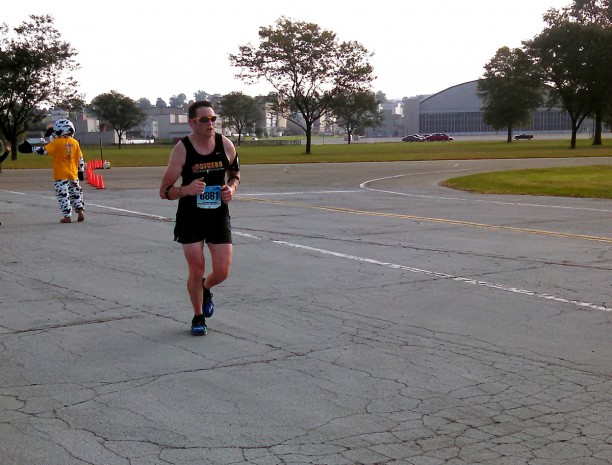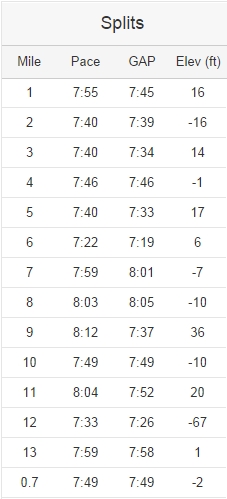I have not spent enough time running this year.
I certainly haven’t spent enough time running to lower my times to where I wanted them to be. At the end of last year, when I drew up my goal sheet for the 2014 season, I wanted a sub-22 minute 5k, and a 1:45 half marathon. But with some fairly ambitious bicycle racing goals alongside, there just hasn’t been much time to train on foot. I’ve dropped my 5k time deep into the 22s, but hadn’t run further than about 6 miles all year. Strava tells me I’ve only logged 26 runs, with a measly total of 126 miles.
That just isn’t enough. Some of my running friends log more than that every month. I’m not putting in anywhere near the volume I should be, if I expect to drop my times and race without injury.
Those were the thoughts going through my head a few weeks ago, as I started to prepare in earnest for my third attempt at the US Air Force Half Marathon. And by prepare, I mean do a last-minute ramp up to see if I could still even run it. Starting just four weeks out, I went to running club a couple times, raced a couple 5k events, and did exactly two “base building” runs, of 7 and 11 miles, respectively. Seven miles felt good. Eleven… not so much.
In terms of dress rehearsals for half marathons, I’ve had worse. I didn’t have a nagging injury. I didn’t bonk on my last long run, as had become a habit last year. And on my last tempo run, I was able to hold pretty close to my intended half marathon pace (8:00/mile) with some level of comfort, despite being sore from CrossFit the day before.
Still, as I finished my taper and started thinking of my strategy for the race, I wasn’t sure what I could expect. On the one hand, I know that I’m stronger and faster than last year. On the other hand, my 11 mile run was a little more brutal than I expected it to be, and I was intentionally going super easy. I hadn’t planned any other half marathons for this fall, choosing instead to leave time open for cyclocross. But if I fell apart in the race and missed my goal by a large margin, maybe I’d need to do another half to redeem myself.
After talking it over with Katie, I figured the only thing to do would be to go out with the pace group for 1:45, and see how long I could hang. I had no idea how long that would be, but I figured I could at least hold onto them through the flat portion of the course, up to the overpass hill at mile 9. After that, it was anybody’s guess. Privately, I just hoped to be under two hours.
The conditions on the morning of the race were as ideal as anybody could ask. Pleasantly cool temperatures, brilliant sunshine, and just a slight breeze at our backs as we moshed across the starting line. The bike ride from home had been a sufficient warm-up, and I felt my body settle into a comfortable rhythm as we crested the first hill, over Huffman Dam. The first three miles passed easily enough at roughly a 7:45 pace, and as we made the left turn onto Skeel Avenue, my anxiety over the race melted away.
I was enjoying the run, something I can’t often say. I had just been joking with friends in the days before the race that I actually hate the act of running, it’s just the finishing that I’m addicted to. But this morning, the combination of the energy of the race, the gorgeous weather, and my body performing at the requested level without much complaint had me grinning behind my flashy new sunglasses.
Five miles in, and contrary to everything I thought I could expect from this race, I felt like the pace group was holding me back. I decided to let my legs stretch a little and see how things went. Ahead of me, I spotted a friend, and increased my pace catch her. We chatted for a minute, and then she turned me loose. She was turning down the gas just as I was turning mine up, so our pace curves crossed. That mile, the sixth, ended up being my fastest of the race, at 7:22.
Upping the pace felt good, but I was mindful that the second half of the race is much harder than the first, and so I slowed back down. The occasional glance over my shoulder revealed that the pace group wasn’t far behind, so I couldn’t afford to relax too much, but neither could I continue burning matches to stay under 7:30.
Before I knew it, I was turning left, toward the familiar sounds of a speed metal band that’s parked at the bottom of the Overpass Hill every year. That band is well placed, because 8 miles into a race, you need a little extra motivation to run up and over a bridge! Either you love the music, and it gets you excited, or you hate it, and you run harder to get away. As in years past, the hill was where my training, especially the runs through my hilly neighborhood, showed. I passed at least a dozen runners going up the hill, and a couple more on the way down the other side, allowing my breathing to accelerate and concentrating on running smooth.
Having dispensed of that challenge, I started to allow myself to think I could make it. Not to the end of the race; that was a foregone conclusion. But if I could just hold together on the last hard segment, the rolling hills on Kaufmann Road, I might even make my goal time! The pace group had caught up to me again as we ran through the back portion of Wright State, just as the full marathon runners merge again with the half-ers. I pulled alongside the pacer and bumped my tempo back up to stay with her, hopeful that I’d be able to hang on.
The rollers on Kaufmann are where my race started to come apart last year. Until I hit them, the race had been going easily, and I was holding an 8:30 or better average. But those hills took it out of me, and I struggled to maintain 9 minute miles to the finish. This year, as Jens Voight would say, the hills didn’t hurt any less, but I did go faster. In fact, I stayed with the pace group and didn’t lose any time at all, despite working very hard to do so!
A mile and a half from the finish, as we passed the next to last water stop, I wanted to feel that I was home free, but I knew that wasn’t true. I had at least twelve minutes of hard work left, and it seemed that the pacer was accelerating. I held on down the hill to Springfield Street, but as the road leveled, I had to let the pacer go. My level of effort already felt like a kick, and it was far too early for that, so I backed off, just a touch, to try and make it to the finish without blowing up early.
The finish loop at the Air Force Marathon is dramatic, to say the least. And long. You pass by the start line on your right, and then enter a 3/4 mile U that takes you between static display aircraft and thousands of fans lining the gates, all accompanied by loud music and an enthusiastic announcer. In previous races, I’d try to start my kick when I was just about even with the finish line on the other side of the U, increasing my pace for the last half mile.
But this year, as we entered the U, we were treated to an unabated headwind that felt like hitting a brick wall! I tried to start my kick as scheduled, but despite my increased heart rate and effort, barely accelerated. The wind was brutal, and so close to the finish, it became demoralizing. After what seemed like hours, I reached the bottom of the loop, turned right, and turned right again. Now it’s a tailwind! I was convinced that between getting dropped by the pacer and beat up by the headwind, I probably wouldn’t meet my goal time. But I still had a chance at a good time, maybe even a big PR, so I let loose. I stretched out my legs, pumped my arms, and let my lungs suck air just as hard as they could, kicking for all I was worth to the finish line.
The finish chute at a big race like the Air Force Marathon is something everybody should experience once. The finish line banner and clock are just visible in the distance, you’re working at an absolute 100%, fans are cheering, friends are screaming your name… It’s magic. It’s not that the all-out effort doesn’t hurt, it’s that you’ve decided that hurting doesn’t matter!
My sprint to the line was strong, but it wasn’t quite enough. I crossed the line in 1:46:04, a mere five seconds off my goal time. Still, that’s 5:45 faster than I went last year! I beat my previous best effort by more than half a mile! And since my rookie effort in 2012, I’ve dropped over a half hour.
With that in mind, it was hard to be anything but overjoyed with how the race went. I may have missed my goal, but I beat everyone’s expectations, including my own, given my minimal preparation for the race. My splits stayed level, and my body held together until the very end of the race, which is a huge improvement over last year, especially on the hills. I may or may not schedule another half marathon before the year is out, to have another crack at my goal time, but even if I don’t, I’ll trot into the offseason feeling satisfied with my progress.



[…] I missed several of mine over the past year. I missed my goal time for a 5k by 23 seconds, for a half marathon by 1:04, and for my Iceman Cometh finish by 1 position. I wasn’t able to achieve some of my goals due […]